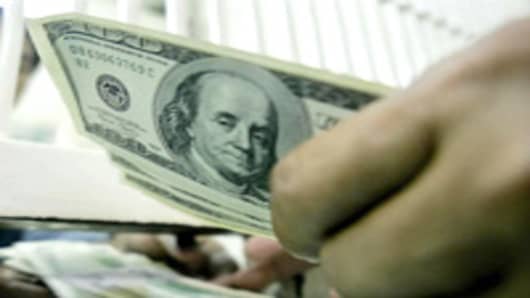The dollar tumbled to a 12-1/2 year low against the Japanese yen on Monday and record levels against the euro and the Swiss franc as emergency liquidity-boosting measures by the Federal Reserve over the weekend failed to ease worries about the U.S. financial sector.
The greenback sold off in reaction to the Fed cutting its discount rate by 25 basis points to 3.25 percent on Sunday and opening up discount window lending to major investment banks, a tool not used since the Great Depression.
Demand for U.S. assets fell even further on the news JP Morgan Chase agreed to pay just $2 a share to buy troubled investment bank Bear Stearns, less than one-tenth of the bank's share price on Friday.
The latest developments in the U.S. financial system stemming from losses in the subprime mortgage market triggered a global market rout on Monday.
The dollar slid as much as 3 percent to below 96 yen, its lowest since 1995 and bringing year-to-date losses to more than 13 percent.
"The U.S. financial sector is the main source of concern," said Matthew Strauss, a currency strategist at RBC Capital in Toronto. "The dollar is clearly oversold against the euro and the yen, but the fear is that there might be other banks in trouble and that's adding pressure."
Strauss said that despite the high levels in dollar-yen and rumors of possible intervention by the Bank of Japan, there were no clear indications the Japanese government is ready to take action to prevent the currency from appreciating further.
The dollar fell as low as 95.77 yen according to Reuters data , and set a historic trough at 0.9637 Swiss francs after breaking below parity last week.
Implied volatility -- a key component of option prices -- in dollar/yen surged to its highest levels in around a decade both on the one-week and one-month C horizon.
"The dollar is suffering from the dual shock of an economic slowdown and a financial crisis," said Teis Knuthsen, head of FX research at Danske Markets in Copenhagen.
In another report on Monday, the U.S. Treasury Department said net overall capital flows in the country fell to its lowest level in four months in January.
The inflows were not sufficient to cover the month's U.S. trade deficit.
"Today's TICs report takes a back seat to tomorrow's FOMC's decision, with market expectations regarding the size of the anticipated cut all over the map," Michael Woolfolk, a senior currency strategist at The Bank of New York Mellon, said in a note.
Short-term U.S. Treasury yields fell to five-year lows as investors expect the Fed could slash overnight rates by up to 100 basis points by the end of its policy meeting on Tuesday.
The euro rose as high as $1.5904, having already added around 4 percent in the first two weeks of March, roughly doubling its year-to-date gains.
Intervention?
The rapid dollar fall fanned talk of possible coordinated dollar-buying intervention from major central banks other than the Bank of Japan.
"From the ECB point of view, these are moves which are not easy to ignore," Dresdner Kleinwort currency strategist Michael Klawitter said.
Central banks in Europe, Japan and the U.S. last jointly intervened in September 2000, propping up the euro after the currency hit an all-time low below $0.85, a loss of nearly 30 percent of its value since its January 1999 launch.
ECB Governing Council Member Klaus Liebscher said in Vienna sharp movements in the currency markets were a matter of concern for the central bank.
"I am concerned about the development... and about the excess volatility, which we see now in the markets," he said.
Japanese Finance Minister Fukushiro Nukaga also said on Monday he is watching currency market moves in cooperation with authorities in the United States and Europe.


